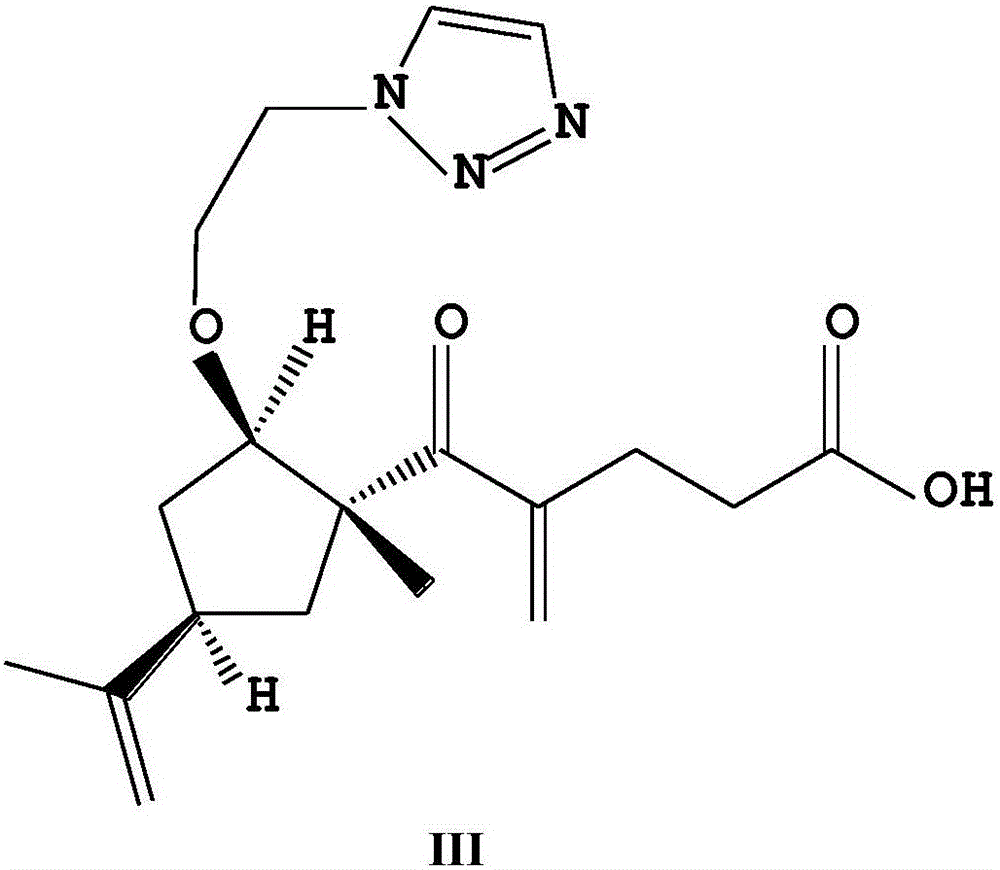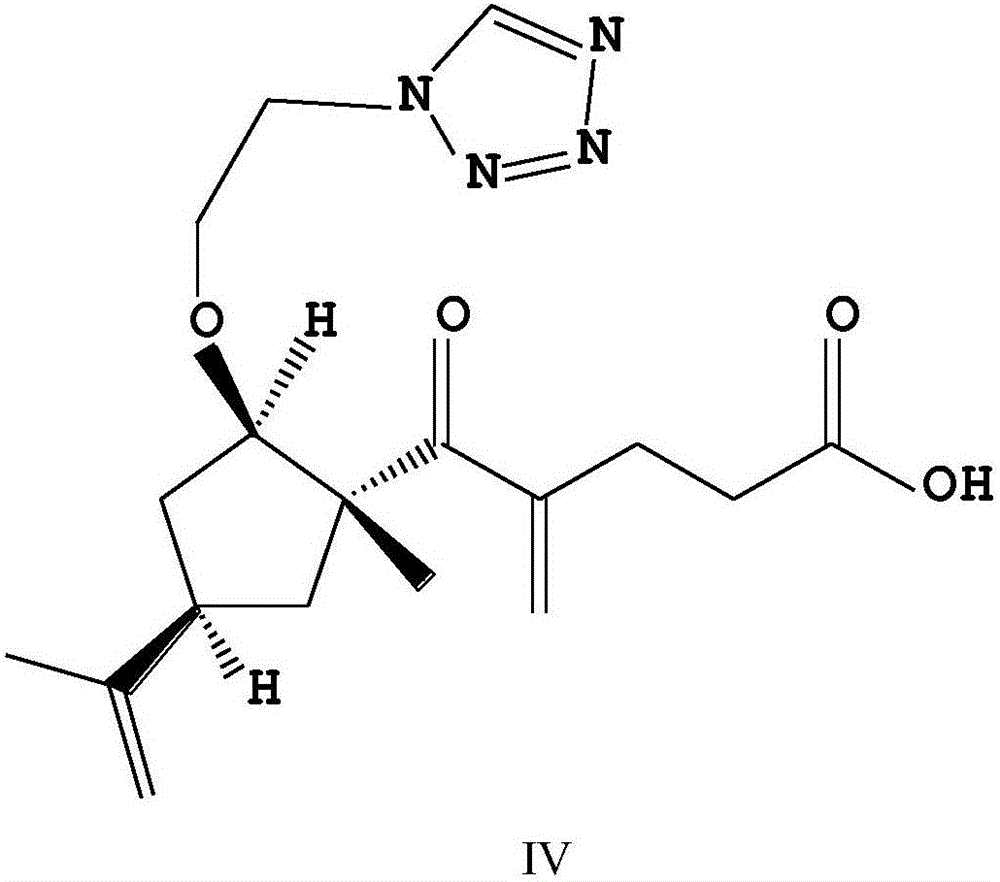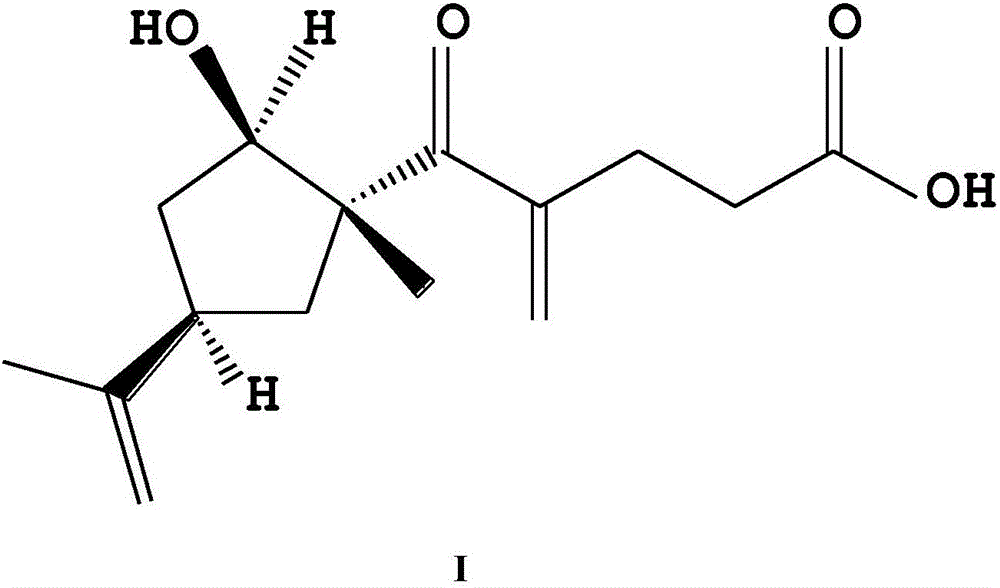Use of composition of triazolyl derivative and 1H-tetrazolyl derivative of Artalbic acid in preparation of anti-liver fibrosis medicines
A technology of liver fibrosis and composition, applied in the fields of organic synthesis and medicinal chemistry, can solve problems such as lack of clinical treatment methods
- Summary
- Abstract
- Description
- Claims
- Application Information
AI Technical Summary
Problems solved by technology
Method used
Image
Examples
Embodiment 1
[0015] The preparation of embodiment 1 compound Artalbic acid
[0016] The preparation method of compound Artalbic acid (I) refers to the literature published by Antonella Maggio et al. (Antonella Maggio et al., 2011. Artalbic acid, a sesquiterpene with an unusual skeleton from Artemisia alba (Asteraceae) from Sicily. Tetrahedron Letters, 52 (2011) 4543–4545) approach.
[0017]
Embodiment 2
[0018] Synthesis of O-bromoethyl derivative (II) of embodiment 2 Artalbic acid
[0019] Compound I (266 mg, 1.00 mmol) was dissolved in 10 mL of benzene, and tetrabutylammonium bromide (TBAB) (0.08 g), 1,2-dibromoethane (3.760 g, 20.00 mmol) and 6 mL of 50% sodium hydroxide solution. The mixture was stirred at 40 °C for 16 h. After 16 hours, the reaction solution was poured into ice water, extracted twice with dichloromethane immediately, and the organic phase solutions were combined. Then the organic phase solution was washed with water and saturated brine for 5 times successively, then dried with anhydrous sodium sulfate, and finally concentrated under reduced pressure to remove the solvent to obtain a crude product. The crude product was purified by silica gel column chromatography (mobile phase: petroleum ether / acetone=100:1.0, v / v), the brown concentrated elution band was collected and the solvent was evaporated to obtain a brown powder of Compound II (272mg, 73%) .
...
Embodiment 3
[0024] Synthesis of O-(triazolyl) ethyl derivative (III) of embodiment 3 Artalbic acid
[0025] Compound II (187mg, 0.5mmol) was dissolved in 25mL of acetonitrile, anhydrous potassium carbonate (345mg, 2.5mmol), potassium iodide (84mg, 0.5mmol) and 1,2,3-triazole (2760mg, 40mmol) were added ), the mixture was heated to reflux for 3h. After the reaction was completed, the reaction solution was poured into ice water, extracted three times with an equal amount of dichloromethane, and the organic phases were combined. The combined organic phases were successively washed with water and saturated brine, dried over anhydrous sodium sulfate, and concentrated under reduced pressure to remove the solvent to obtain a crude product. The crude product was purified by silica gel column chromatography (mobile phase: petroleum ether / acetone=100:1.0, v / v), and the light yellow concentrated elution band was collected to obtain compound III as a light yellow colloidal solid (124.5mg, 69% ).
...
PUM
 Login to View More
Login to View More Abstract
Description
Claims
Application Information
 Login to View More
Login to View More - R&D
- Intellectual Property
- Life Sciences
- Materials
- Tech Scout
- Unparalleled Data Quality
- Higher Quality Content
- 60% Fewer Hallucinations
Browse by: Latest US Patents, China's latest patents, Technical Efficacy Thesaurus, Application Domain, Technology Topic, Popular Technical Reports.
© 2025 PatSnap. All rights reserved.Legal|Privacy policy|Modern Slavery Act Transparency Statement|Sitemap|About US| Contact US: help@patsnap.com



